Artworks installed in public space might get the approval of local governments but that doesn’t mean that they will make a good impression on passersby. Or on people genuinely interested in art. Too many public artworks i come across are bland and sad addition to the city or the landscape. I suspect that some of them ‘dialogue’ with the surrounding space only in the mind of the artists and/or the commissioners.
Fortunately there are exceptions to the rule (and the future might even get rosier.) Take the province of Limburg in Belgium where Z33, the house for contemporary art has launched pit – art in public space. A few years ago, the art space invited established names and young talents to visit several sites in the region, pick up the one they’d like to work with and then submit a project that would engage with the cultural background of the area and entice passers-by to look differently at the surroundings. The result is pit – art in public space.
 Florentijn Hofman, De Badeend, Neerpelt, 2012
Florentijn Hofman, De Badeend, Neerpelt, 2012
 Florentijn Hofman, De Badeend, Lommel, 2012
Florentijn Hofman, De Badeend, Lommel, 2012
 Florentijn Hofman, De Badeend, 2012
Florentijn Hofman, De Badeend, 2012
Badeend (the Rubber Duck) by Florentijn Hofman kicked off Z33’s art in public space programme back in 2008. Since then, the duck has been deflated, inflated again, turned into bright shoulder bags and resuscitated on several occasions. In 2011, pit commissions have spread all over the region of Borgloon-Heers and they might venture even further in the coming years.
 Gijs Van Vaerenbergh, Reading between the Lines. Photo: Kristof Vrancken / Z33
Gijs Van Vaerenbergh, Reading between the Lines. Photo: Kristof Vrancken / Z33
 Gijs Van Vaerenbergh, Reading between the Lines. Photo: Kristof Vrancken / Z33
Gijs Van Vaerenbergh, Reading between the Lines. Photo: Kristof Vrancken / Z33
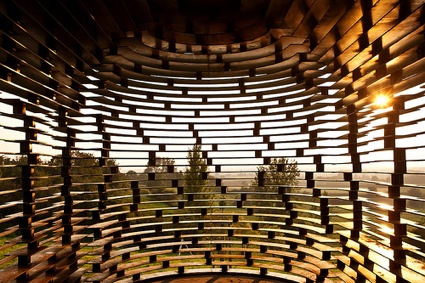 Gijs Van Vaerenbergh, Reading between the Lines. Photo: Kristof Vrancken / Z33
Gijs Van Vaerenbergh, Reading between the Lines. Photo: Kristof Vrancken / Z33
 Gijs Van Vaerenbergh, Reading between the Lines. Photo: Kristof Vrancken / Z33
Gijs Van Vaerenbergh, Reading between the Lines. Photo: Kristof Vrancken / Z33
The programme’s most talked about public artwork is the see-through building of steel built by architects duo Pieterjan Gijs and Arnout Van Vaerenbergh in the middle of Borgloon’s corn and apple fields. The 10 metre high structure has the archetypal shape of the churches found in the region. Because it is both almost transparent and highly visible, the construction provides an opportunity to have another look at the landscape. It also attracted tourists who would otherwise have never thought of visiting the area (some of them even came from Japan after the church had made the cover of an architecture magazine.)
The building is smaller than i had thought but it is just as stunning as on the photos above.
 Wesley Meuris, Memento. Photo: Kristof Vrancken / Z33
Wesley Meuris, Memento. Photo: Kristof Vrancken / Z33
 Wesley Meuris, Memento. Photo: Kristof Vrancken / Z33
Wesley Meuris, Memento. Photo: Kristof Vrancken / Z33
 Wesley Meuris, Memento. Photo: Kristof Vrancken / Z33
Wesley Meuris, Memento. Photo: Kristof Vrancken / Z33
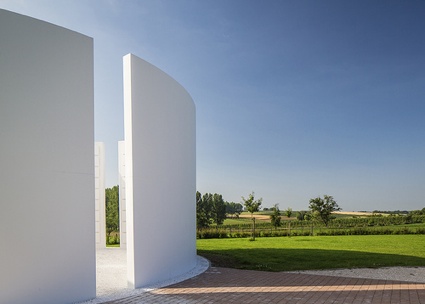 Wesley Meuris, Memento. Photo: Kristof Vrancken / Z33
Wesley Meuris, Memento. Photo: Kristof Vrancken / Z33
Wesley Meuris‘s Memento is a sculpture built by the Borgloon cemetery. The steel structure, with its peculiar acoustics and sci-fi whiteness, envelops the visitor while giving them a perspective on the sky and slices of the surrounding landscape.
I think it’s the first time i entered a cemetery to see a contemporary art work.
 Dré Wapenaar, Tranendreef. Photo: Kristof Vrancken / Z33
Dré Wapenaar, Tranendreef. Photo: Kristof Vrancken / Z33
 Dré Wapenaar, Tranendreef. Photo: Kristof Vrancken / Z33
Dré Wapenaar, Tranendreef. Photo: Kristof Vrancken / Z33
 Dré Wapenaar, Tranendreef. Photo: Kristof Vrancken / Z33
Dré Wapenaar, Tranendreef. Photo: Kristof Vrancken / Z33
 Dré Wapenaar, Tranendreef. Photo: Kristof Vrancken / Z33
Dré Wapenaar, Tranendreef. Photo: Kristof Vrancken / Z33
Some of the works remain in place for several years, others can be seen for only a short time. Last Summer, Dré Wapenaar hung four tear-shaped tents on trees. People could book a tree and spend the night up there.
 Ardie Van Bommel, Field Furniture “Pure Nature”. Photo: Kristof Vrancken / Z33
Ardie Van Bommel, Field Furniture “Pure Nature”. Photo: Kristof Vrancken / Z33
Field Furniture “Pure Nature” by Ardie Van Bommel completed the tree tents. The designer had installed toilets, showers and barbecue unit where the tree guests could clean up, eat and socialize.
 Tadashi Kawamata, project Burchtheuvel. Photo: Kristof Vrancken / Z33
Tadashi Kawamata, project Burchtheuvel. Photo: Kristof Vrancken / Z33
 Tadashi Kawamata, project Burchtheuvel. Photo: Kristof Vrancken / Z33
Tadashi Kawamata, project Burchtheuvel. Photo: Kristof Vrancken / Z33
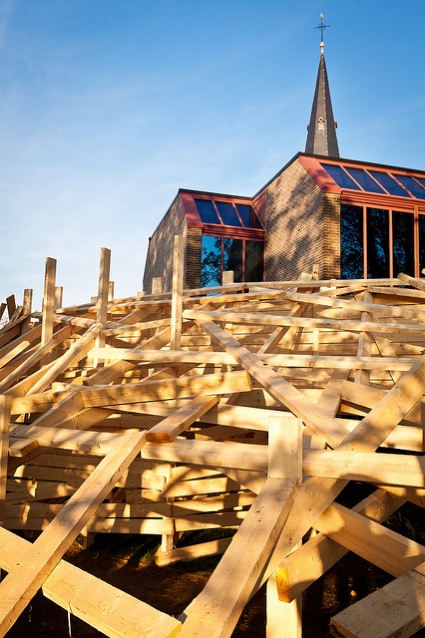 Tadashi Kawamata, project Burchtheuvel. Photo: Kristof Vrancken / Z33
Tadashi Kawamata, project Burchtheuvel. Photo: Kristof Vrancken / Z33
 Tadashi Kawamata, project Burchtheuvel. Photo: Kristof Vrancken / Z33
Tadashi Kawamata, project Burchtheuvel. Photo: Kristof Vrancken / Z33
Japanese artist Tadashi Kawamata headed a workshop where students in architecture, interior architecture and visual arts designed and built Project Burchtheuvel, a wooden sculpture where people can walk up, observe the landscape and relax. The work also scored brownie points because it almost hid the nearby library, a building which hideousness i’d rather not comment.
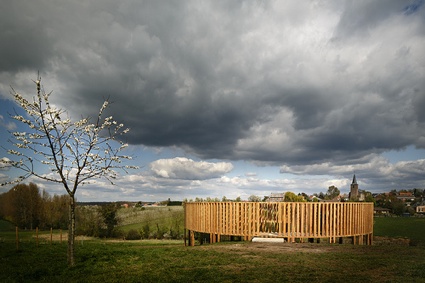 Aeneas Wilder, Untitled #158. Photo: Kristof Vrancken / Z33
Aeneas Wilder, Untitled #158. Photo: Kristof Vrancken / Z33
 Aeneas Wilder, Untitled #158. Photo: Kristof Vrancken / Z33
Aeneas Wilder, Untitled #158. Photo: Kristof Vrancken / Z33
 Aeneas Wilder, Untitled #158. Photo: Kristof Vrancken / Z33
Aeneas Wilder, Untitled #158. Photo: Kristof Vrancken / Z33
 Aeneas Wilder, Untitled #158. Photo: Kristof Vrancken / Z33
Aeneas Wilder, Untitled #158. Photo: Kristof Vrancken / Z33
Aeneas Wilder built a round construction with a 360º view on the landscape near the Monastery of Colen in Kerniel. Walking around the structure reminds visitors of a meditative promenade in the internal garden of a monastery. Not that everyone uses the space to collect their thoughts. When i visited children were using it to skate and cycle.
And the list goes on…
Paul Devens, Proximity Effect (in the Servatius church in Groot-Loon)
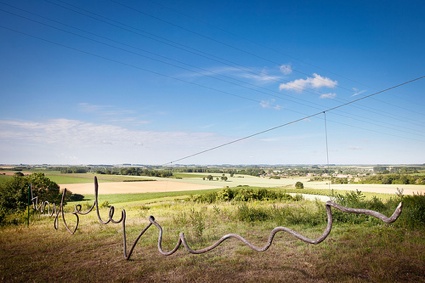 Fred Eerdekens, Twijfelgrens. Photo: Kristof Vrancken / Z33
Fred Eerdekens, Twijfelgrens. Photo: Kristof Vrancken / Z33
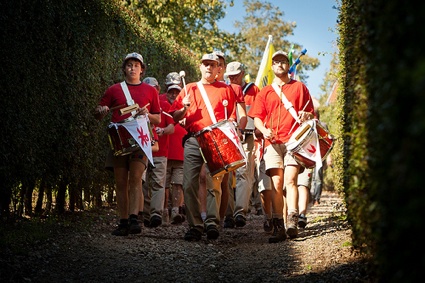 Photo: Kristof Vrancken / Z33
Photo: Kristof Vrancken / Z33
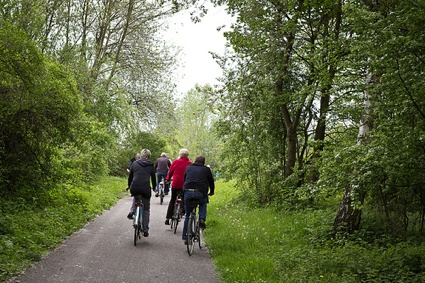 Photo: Kristof Vrancken / Z33
Photo: Kristof Vrancken / Z33
 Photo: Kristof Vrancken / Z33
Photo: Kristof Vrancken / Z33
The artworks are also accompanied by workshops, side activities and public events. The smartest way to see them is to rent a bike and cycle from one to the other.
This post wasn’t sponsored in any way by the local tourism office. Maybe next time i’ll try and get a gigantic inflatable duck though.
pit | Z33 – art in public space: photo collection.
